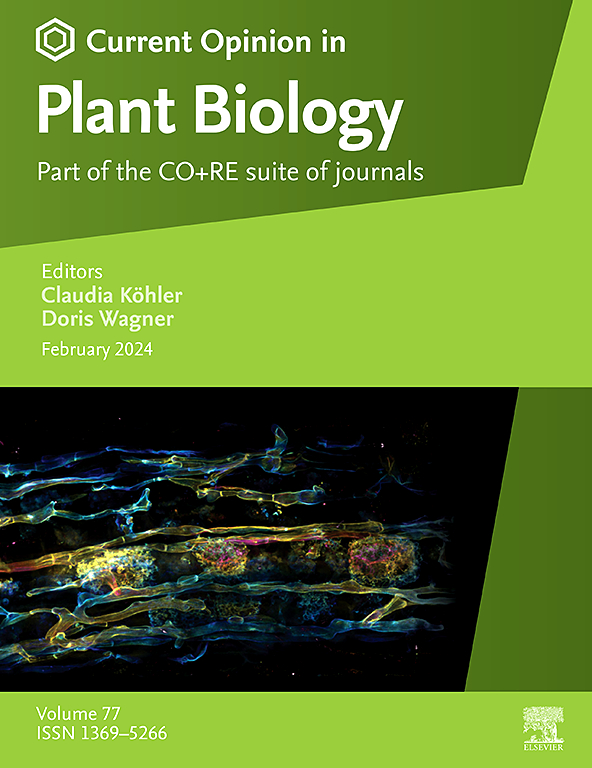茄科生物碱的进化
IF 7.5
2区 生物学
Q1 PLANT SCIENCES
引用次数: 0
摘要
生物碱是一种多种含氮代谢物,参与关键的生物相互作用,如防御食草动物和病原体以及招募传粉者。由于茄科植物产生的生物碱种类繁多,如烟碱、tropane生物碱(TAs)、甾体糖生物碱(SGAs)和辣椒素等,因此茄科植物已成为研究生物碱进化的模型。最近的多组学和比较基因组学研究扩大了我们对驱动生物碱多样化的遗传和进化机制的理解。这些代谢物是由家族内的特定分支产生的,通常是对选择压力的反应,例如草食动物和病原体的共同进化,这些压力通过多样化和减少来塑造生物碱谱。基因组复制、重排和基因渗入等进化过程也在新的生物碱途径的出现中发挥了重要作用,促进了代谢适应。茄科植物在生物碱生产上既有趋同又有分化,某些生物碱在不同谱系中独立产生。值得注意的是,生物合成基因簇(BGCs)和基因复制与生物碱多样化有关,这些区域的结构和功能驱动代谢变异性。此外,人类对烟草和辣椒等植物的驯化影响了作物物种的生物碱谱,特别是在抗虫害和风味方面。该科生物碱的进化不仅塑造了植物的防御机制,而且对人类健康和农业具有重要意义。本文综述了茄科生物碱的遗传、生态和人类影响之间的动态相互作用。本文章由计算机程序翻译,如有差异,请以英文原文为准。
Alkaloid evolution in the Solanaceae
Alkaloids are a diverse class of nitrogen-containing metabolites involved in key biotic interactions, such as defense against herbivores and pathogens and the recruitment of pollinators. The Solanaceae family has served as a model for studying alkaloid evolution, due to the varied types of alkaloids it produces, such as nicotinoids, tropane alkaloids (TAs), steroidal glycoalkaloids (SGAs), and capsaicinoids. Recent multi-omics and comparative genomics studies have expanded our understanding of the genetic and evolutionary mechanisms driving alkaloid diversification. These metabolites are produced by specific clades within the family, often in response to selective pressures such as herbivore and pathogen coevolution, which shape alkaloid profiles through both diversification and reduction. Evolutionary processes like genome duplications, rearrangements, and introgressions have also played a significant role in the emergence of new alkaloid pathways, promoting metabolic adaptations. The Solanaceae family exhibits both convergence and divergence in alkaloid production, with certain alkaloids arising independently in different lineages. Notably, biosynthetic gene clusters (BGCs) and gene duplication have been linked to alkaloid diversification, with the structure and function of these regions driving metabolic variability. Furthermore, human domestication of plants such as tobacco and chili peppers has influenced the alkaloid profiles of crop species, particularly in terms of pest resistance and flavor. The evolution of alkaloids in this family has not only shaped plant defense mechanisms but also has important implications for human health and agriculture. This review highlights the dynamic interplay between genetics, ecology, and human influence in the evolution of alkaloids within the Solanaceae family.
求助全文
通过发布文献求助,成功后即可免费获取论文全文。
去求助
来源期刊

Current opinion in plant biology
生物-植物科学
CiteScore
16.30
自引率
3.20%
发文量
131
审稿时长
6-12 weeks
期刊介绍:
Current Opinion in Plant Biology builds on Elsevier's reputation for excellence in scientific publishing and long-standing commitment to communicating high quality reproducible research. It is part of the Current Opinion and Research (CO+RE) suite of journals. All CO+RE journals leverage the Current Opinion legacy - of editorial excellence, high-impact, and global reach - to ensure they are a widely read resource that is integral to scientists' workflow.
 求助内容:
求助内容: 应助结果提醒方式:
应助结果提醒方式:


